重大版小学英语五年级上册教(学)案(Unit 3)
- 格式:docx
- 大小:28.93 KB
- 文档页数:5
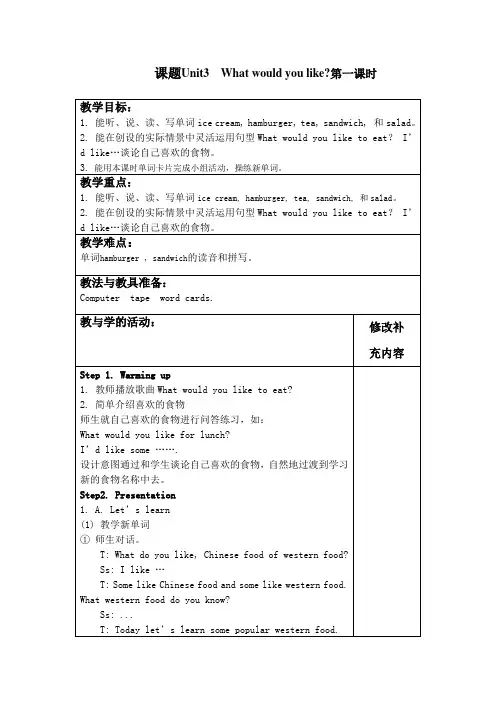
课题Unit3 What would you like?第一课时课题Unit3 What would you like?第二课时1、let’s talk1) I’m hungry. What would you like to eat?T: It’s ten thirsty now. I’m hungry.S1: Have some eggs.S2: Have some rice and fish. ...T: I don’t like chicken.(教师运用否定的回答,引导学生用句式What would you like to eat?进行提问,然后运用I’d like...来进行回答)2) I’m thirsty. What would you like to drink?3) let’s talk教师播放录音,学生听对话试着回答问题:是谁在对话?他们在聊什么再听录音,说说爸爸和妈妈在讲什么,sarah 和爸爸又在讨论什么看句子,听录音,学生跟读句子学生自己试着朗读对话。
2、let’s try1)认读选项中的单词2)听录音,完成内容,并核对3、情景对话教师将所学食物卡片拿在手中,请一名学生任意抽取1、2张单词卡片,然后学生根据单词卡片上的单词说:I’m thirsty\hungry,班内其他学生一起提问What would you like to drink\eat? ,学生根据自己手中的单词进行相应的回答:I’d like...Step 3. Practice师生一起认读书的单词,并集体朗读几遍上请两位学生分别扮演Amy 和Oliver 进行对话掩饰Step 4. Homework1.Write the words on the homework.2.Do the exercise.板书设计:Unit 3 What would you like?I’m thirsty.What would you like to eat / drink?I’d like …Here you are.教学反思:课题Unit3 What would you like?第三课时课题Unit3 What would you like?第四课时课题Unit3 What would you like?第五课时课题Unit3 What would you like?第六课时。
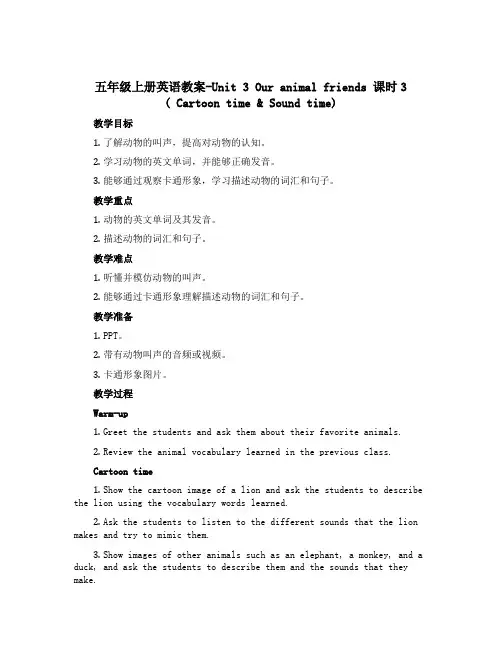
五年级上册英语教案-Unit 3 Our animal friends 课时3( Cartoon time & Sound time)教学目标1.了解动物的叫声,提高对动物的认知。
2.学习动物的英文单词,并能够正确发音。
3.能够通过观察卡通形象,学习描述动物的词汇和句子。
教学重点1.动物的英文单词及其发音。
2.描述动物的词汇和句子。
教学难点1.听懂并模仿动物的叫声。
2.能够通过卡通形象理解描述动物的词汇和句子。
教学准备1.PPT。
2.带有动物叫声的音频或视频。
3.卡通形象图片。
教学过程Warm-up1.Greet the students and ask them about their favorite animals.2.Review the animal vocabulary learned in the previous class.Cartoon time1.Show the cartoon image of a lion and ask the students to describe the lion using the vocabulary words learned.2.Ask the students to listen to the different sounds that the lion makes and try to mimic them.3.Show images of other animals such as an elephant, a monkey, and a duck, and ask the students to describe them and the sounds that they make.Sound time1.Introduce different sounds that animals make using audio or video.2.Ask the students to identify the animals that are making the sounds.3.Have the students mimic the animal sounds they have heard.Practice1.Divide the class into small groups and have them act out the sounds and movements of different animals.2.The teacher can call out an animal for the students to act out and make the sound of.3.Have the students work in pairs and create a dialogue using the animal vocabulary and descriptions learned.Consolidation1.Review the animal vocabulary and the different sounds that animals make.2.Encourage the students to think about how they can use this knowledge to communicate better with animals.作业1.Draw a picture of your favorite animal and write a short description using the vocabulary learned in class.2.Practice making the different sounds that animals make at home.总结通过本课的学习,学生通过观察卡通形象、听取音频和视频,提高了对动物的认知,学习了动物的英文单词及其发音,并能够通过词汇和句子描述动物。
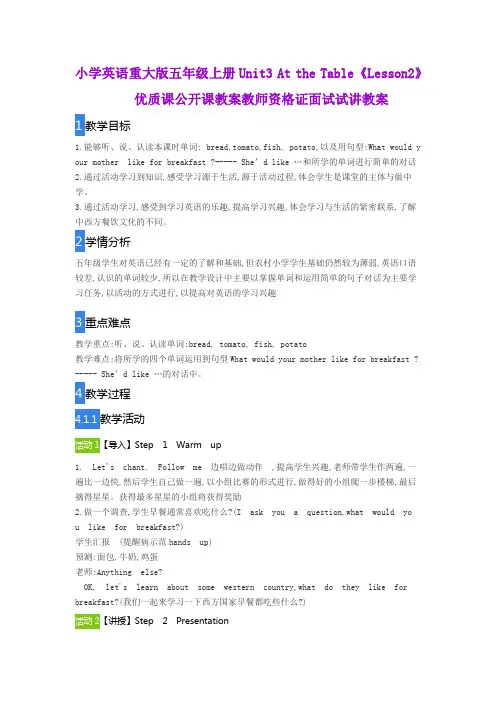
小学英语重大版五年级上册Unit3 At the Table《Lesson2》优质课公开课教案教师资格证面试试讲教案1教学目标1.能够听、说、认读本课时单词: bread,tomato,fish, potato,以及用句型:What would y our mother like for breakfast ?----- She’d like …和所学的单词进行简单的对话2.通过活动学习到知识,感受学习源于生活,源于活动过程,体会学生是课堂的主体与做中学。
3.通过活动学习,感受到学习英语的乐趣,提高学习兴趣,体会学习与生活的紧密联系,了解中西方餐饮文化的不同。
2学情分析五年级学生对英语已经有一定的了解和基础,但农村小学学生基础仍然较为薄弱,英语口语较差,认识的单词较少,所以在教学设计中主要以掌握单词和运用简单的句子对话为主要学习任务,以活动的方式进行,以提高对英语的学习兴趣3重点难点教学重点:听、说、认读单词:bread, tomato, fish, potato教学难点:将所学的四个单词运用到句型What would your mother like for breakfast ? ----- She’d like …的对话中。
4教学过程教学活动1【导入】Step 1 Warm up1. Let's chant. Follow me 边唱边做动作,提高学生兴趣,老师带学生作两遍,一遍比一边快,然后学生自己做一遍,以小组比赛的形式进行,做得好的小组爬一步楼梯,最后摘得星星。
获得最多星星的小组将获得奖励2.做一个调查,学生早餐通常喜欢吃什么?(I ask you a question,what would you like for breakfast?)学生汇报(提醒病示范hands up)预测:面包,牛奶,鸡蛋老师:Anything else?OK, let's learn about some western country,what do they like for breakfast?(我们一起来学习一下西方国家早餐都吃些什么?)2【讲授】Step 2 Presentation。
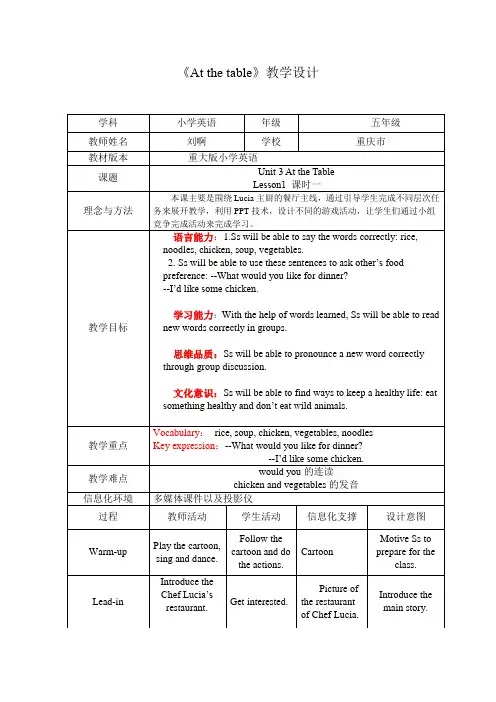
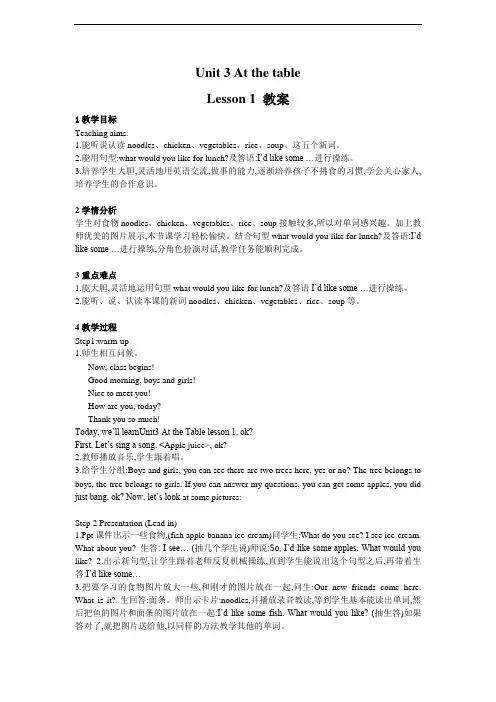
Unit 3 At the tableLesson 1 教案1教学目标Teaching aims:1.能听说认读noodles、chicken、vegetables、rice、soup、这五个新词。
2.能用句型:what would you like for lunch?及答语:I’d like some …进行操练。
3.培养学生大胆,灵活地用英语交流,做事的能力,逐渐培养孩子不挑食的习惯,学会关心家人,培养学生的合作意识。
2学情分析学生对食物noodles、chicken、vegetables、rice、soup接触较多,所以对单词感兴趣。
加上教师优美的图片展示,本节课学习轻松愉快。
结合句型what would you like for lunch?及答语:I’d like some …进行操练,分角色扮演对话,教学任务能顺利完成。
3重点难点1.能大胆,灵活地运用句型what would you like for lunch?及答语I’d like some …进行操练。
2.能听、说、认读本课的新词noodles、chicken、vegetables、rice、soup等。
4教学过程Step1:warm-up1.师生相互问候。
Now, class begins!Good morning, boys and girls!Nice to meet you!How are you, today?Thank you so much!Today, we’ll learnUnit3 At the Table lesson 1, ok?First, Let’s sing a song, <Apple juice>, ok?2.教师播放音乐,学生跟着唱。
3.给学生分组:Boys and girls, you can see there are two trees here, yes or no? The tree belongs to boys, the tree belongs to girls. If you can answer my questions, you can get some apples, you did just bang, ok? Now, let’s look at some pictures:Step 2 Presentation (Lead in)1.Ppt课件出示一些食物,(fish apple banana ice-cream)问学生;What do you see? I see ice-cream. What about you? 生答: I see… (抽几个学生说)师说:So, I’d like some apples. What would you like?2.出示新句型,让学生跟着老师反复机械操练,直到学生能说出这个句型之后,再带着生答:I’d like some…3.把要学习的食物图片放大一些,和刚才的图片放在一起,问生:Our new friends come here. What is it? 生回答:面条。
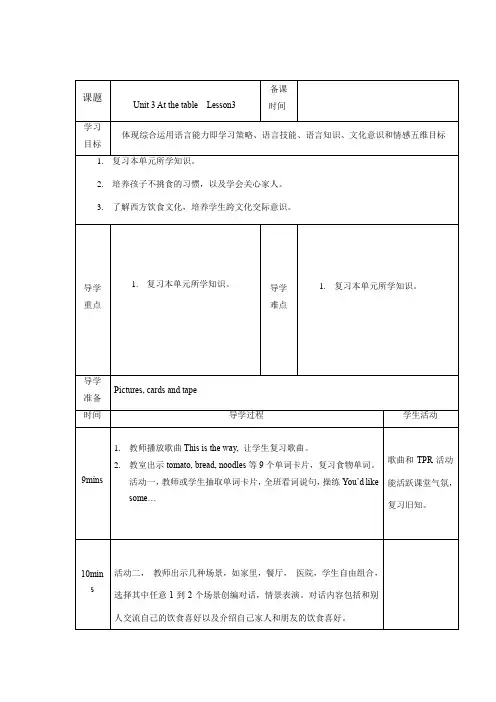
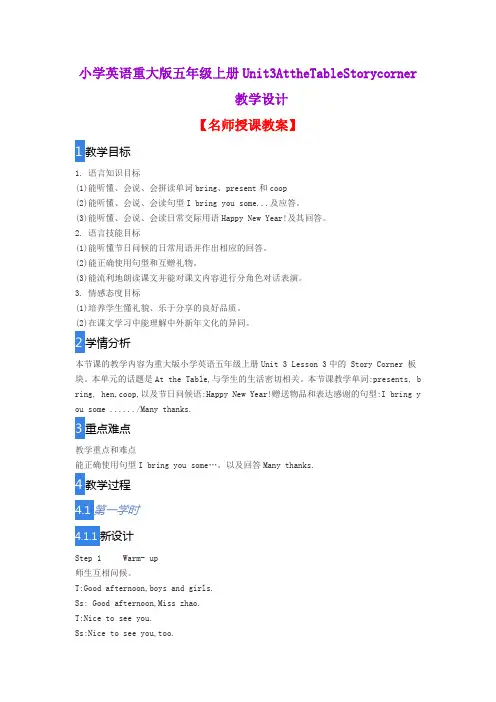
小学英语重大版五年级上册Unit3AttheTableStorycorner教学设计【名师授课教案】1教学目标1. 语言知识目标(1)能听懂、会说、会拼读单词bring、present和coop(2)能听懂、会说、会读句型I bring you some...及应答。
(3)能听懂、会说、会读日常交际用语Happy New Year!及其回答。
2. 语言技能目标(1)能听懂节日问候的日常用语并作出相应的回答。
(2)能正确使用句型和互赠礼物。
(3)能流利地朗读课文并能对课文内容进行分角色对话表演。
3. 情感态度目标(1)培养学生懂礼貌、乐于分享的良好品质。
(2)在课文学习中能理解中外新年文化的异同。
2学情分析本节课的教学内容为重大版小学英语五年级上册Unit 3 Lesson 3中的 Story Corner 板块。
本单元的话题是At the Table,与学生的生活密切相关。
本节课教学单词:presents, b ring, hen,coop,以及节日问候语:Happy New Year!赠送物品和表达感谢的句型:I bring y ou some ....../Many thanks.3重点难点教学重点和难点能正确使用句型I bring you some…。
以及回答Many thanks.4教学过程4.1第一学时新设计Step 1 Warm- up师生互相问候。
T:Good afternoon,boys and girls.Ss: Good afternoon,Miss zhao.T:Nice to see you.Ss:Nice to see you,too.。
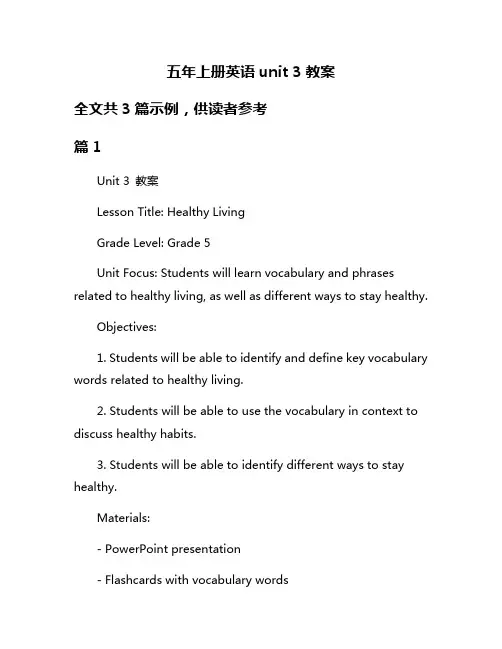
五年上册英语unit 3教案全文共3篇示例,供读者参考篇1Unit 3 教案Lesson Title: Healthy LivingGrade Level: Grade 5Unit Focus: Students will learn vocabulary and phrases related to healthy living, as well as different ways to stay healthy.Objectives:1. Students will be able to identify and define key vocabulary words related to healthy living.2. Students will be able to use the vocabulary in context to discuss healthy habits.3. Students will be able to identify different ways to stay healthy.Materials:- PowerPoint presentation- Flashcards with vocabulary words- Worksheets for group activities- Videos on healthy living habitsIntroduction (10 minutes):- Start the lesson by discussing with students the importance of staying healthy.- Show a short video on healthy habits and ask students to list some of the habits they saw in the video.- Introduce key vocabulary words related to healthy living using flashcards.Vocabulary Practice (15 minutes):- Have students work in pairs to match the vocabulary words to their definitions.- Ask students to write sentences using the vocabulary words to demonstrate understanding.Reading Comprehension (20 minutes):- Provide students with a short reading passage about healthy living habits.- Ask students to read the passage and answer comprehension questions about the text.Group Activity (20 minutes):- Divide students into small groups and give each group a worksheet with scenarios related to healthy living.- Ask students to discuss the scenarios and come up with a plan for how to stay healthy in each situation.Wrap-Up (10 minutes):- Review key vocabulary words and concepts discussed in the lesson.- Have students share one healthy habit they plan to practice based on what they learned in the lesson.Assessment:- Assess students on their ability to identify and define key vocabulary words, as well as their comprehension of the reading passage and their participation in the group activity.Homework:- Ask students to write a paragraph about their own healthy living habits and goals.篇2Unit 3 Lesson PlanGrade: Five (Ages 10-11)Subject: EnglishUnit: Food and NutritionKey Vocabulary: fruit, vegetable, dairy, protein, grain, breakfast, lunch, dinner, snack, healthy, unhealthy, balanced dietLesson Objectives:1. Students will be able to identify different food groups and categorize them.2. Students will understand the importance of a balanced diet for maintaining good health.3. Students will be able to discuss and share their own eating habits and preferences.4. Students will create a poster promoting healthy eating habits.Materials Needed:- Pictures of different foods from each food group- Chart paper and markers- Arts and craft supplies for making posters- Worksheet on food groupsProcedure:1. Start the lesson by asking students about their favorite foods. Discuss with the class what types of foods they like to eat and why.2. Introduce the concept of food groups to the students. Show them pictures of different foods and ask them to categorize them into fruit, vegetable, dairy, protein, and grain groups.3. Discuss the importance of each food group in maintaininga balanced diet. Explain to the students how each food group provides essential nutrients for the body.4. Show students a chart with examples of healthy and unhealthy foods. Discuss with them the importance of making healthy food choices.5. Have the students work in pairs to complete a worksheet on food groups. They can use the pictures provided to help them categorize different foods.6. After completing the worksheet, have a class discussion on the importance of eating a balanced diet. Ask students to share their own eating habits and preferences.7. Divide the class into groups and assign them the task of creating a poster promoting healthy eating habits. Provide them with art supplies and let them be creative with their designs.8. After the posters are completed, have each group present their work to the class. Encourage students to explain the importance of eating a variety of foods from each food group.9. Conclude the lesson by summarizing the key points discussed and emphasizing the importance of maintaining a healthy and balanced diet.Assessment:- Students will be assessed based on their participation in class discussions, completion of the worksheet, and the creativity of their posters.Extension Activities:- Students can research and create a menu for a balanced meal for a day.- Students can make a collage of healthy food choices.- Students can write a short paragraph on why it is important to eat a balanced diet.Overall, this lesson aims to educate students on the importance of making healthy food choices and maintaining a balanced diet for good health and well-being. By engaging students in discussions and activities, they will gain a better understanding of how food choices impact their overall health.篇3Unit 3教案Unit Title: At the LibraryGrade: FiveMain Goals:1. To introduce vocabulary related to the library and reading.2. To practice reading and comprehension skills.3. To improve students' speaking and writing abilities.Language Skills:1. Listening2. Speaking3. Reading4. WritingMaterials Needed:1. Flashcards with library vocabulary2. Worksheets with reading passages3. Whiteboard and markers4. Reading booksLesson Plan:Introduction (5 mins):- Greet the students and introduce the topic of the lesson: "At the Library."- Show flashcards with library vocabulary and ask the students to repeat after you.- Review any vocabulary related to the library that the students may already know.Vocabulary (10 mins):- Present and explain new vocabulary related to the library, such as books, shelves, librarian, etc.- Use the flashcards to help students remember the new words.- Drill the vocabulary with the students, both individually and as a group.Reading Activity (15 mins):- Hand out worksheets with reading passages about visiting the library.- Read the passages aloud to the students and ask comprehension questions afterwards.- Have students read the passages quietly and answer the questions on their own or in pairs.- Go over the answers together as a class.Speaking Activity (15 mins):- Divide the students into pairs and have them discuss their favorite books or authors.- Encourage students to ask each other questions about their reading preferences.- Circulate around the class to monitor the students' speaking abilities and offer assistance as needed.- Have some pairs share their conversations with the class.Writing Activity (15 mins):- Ask students to write a short paragraph about their last visit to the library.- Provide them with writing prompts to help them organize their thoughts.- Monitor the students as they write and offer feedback on their grammar and vocabulary usage.- Have some students read their paragraphs aloud to the class.Conclusion (5 mins):- Summarize the key points of the lesson, including the new vocabulary and reading passages.- Ask students to share what they have learned about the library today.- Remind students to visit the library and continue reading regularly.- Thank the students for their participation and effort in the lesson.Homework:- Assign a reading task for students to complete outside of class, such as finishing a book or researching a new author.- Encourage students to write a book review or summary for the next lesson.Assessment:- Monitor students' participation and understanding throughout the lesson.- Evaluate students' written work for grammar, vocabulary, and coherence.- Provide feedback to students on their speaking skills and comprehension of the reading passages.。
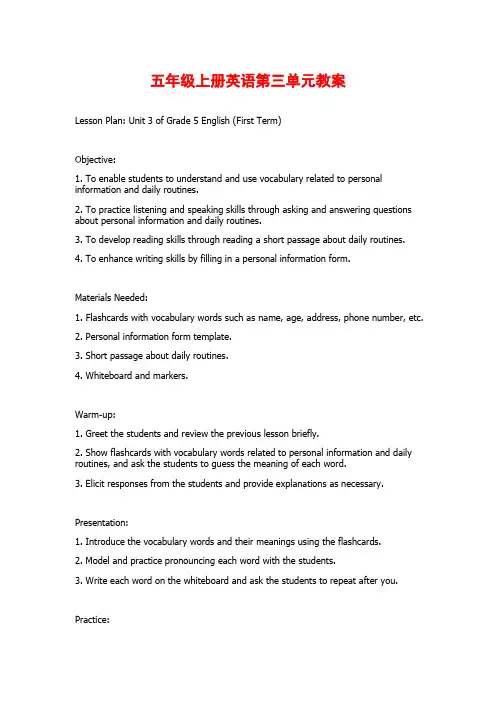
五年级上册英语第三单元教案Lesson Plan: Unit 3 of Grade 5 English (First Term)Objective:1. To enable students to understand and use vocabulary related to personal information and daily routines.2. To practice listening and speaking skills through asking and answering questions about personal information and daily routines.3. To develop reading skills through reading a short passage about daily routines.4. To enhance writing skills by filling in a personal information form.Materials Needed:1. Flashcards with vocabulary words such as name, age, address, phone number, etc.2. Personal information form template.3. Short passage about daily routines.4. Whiteboard and markers.Warm-up:1. Greet the students and review the previous lesson briefly.2. Show flashcards with vocabulary words related to personal information and daily routines, and ask the students to guess the meaning of each word.3. Elicit responses from the students and provide explanations as necessary.Presentation:1. Introduce the vocabulary words and their meanings using the flashcards.2. Model and practice pronouncing each word with the students.3. Write each word on the whiteboard and ask the students to repeat after you. Practice:1. Divide the class into pairs or small groups.2. Distribute personal information form templates to each pair or group.3. Instruct the students to fill in the form using their personal information, and encourage them to ask their partner or group members for information they are not sure about.4. Monitor the students' progress and provide assistance as needed.Production:1. Ask a few students to share their completed personal information forms with the class.2. Lead a discussion about personal information and daily routines, using the completed forms as prompts.3. Encourage the students to ask and answer questions about each other's personal information and daily routines.4. Monitor and guide the discussion, providing feedback and corrections as needed. Reading:1. Introduce the short passage about daily routines to the students.2. Read the passage aloud to the students, pausing after each sentence to check for comprehension.3. Ask students to read the passage silently and answer comprehension questions.4. Discuss the answers as a class and clarify any points of confusion.Closure:1. Review the key vocabulary words and their meanings.2. Recap the lesson objectives and highlight the language skills practiced during the lesson.3. Assign any homework task related to personal information or daily routines.Note: The duration of this lesson plan may vary depending on the teaching pace and class size. Additional activities such as role plays or writing exercises can be included to further reinforce the lesson objectives.。

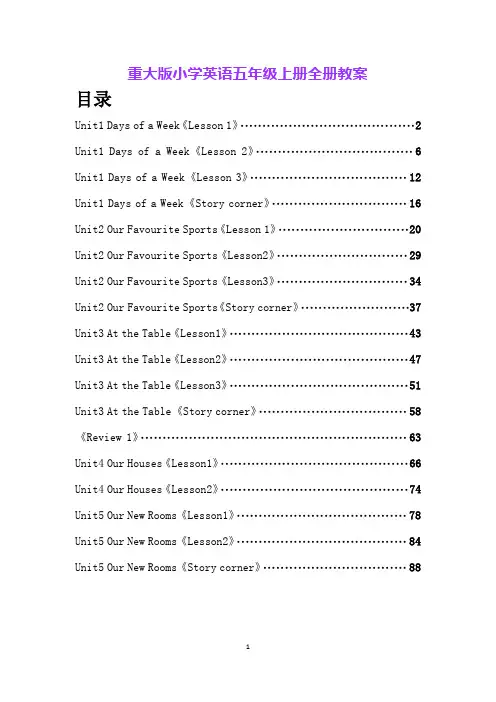
重大版小学英语五年级上册全册教案目录Unit1 Days of a Week《Lesson 1》 (2)Unit1 Days of a Week《Lesson 2》 (6)Unit1 Days of a Week《Lesson 3》 (12)Unit1 Days of a Week《Story corner》 (16)Unit2 Our Favourite Sports《Lesson 1》 (20)Unit2 Our Favourite Sports《Lesson2》 (29)Unit2 Our Favourite Sports《Lesson3》 (34)Unit2 Our Favourite Sports《Story corner》 (37)Unit3 At the Table《Lesson1》 (43)Unit3 At the Table《Lesson2》 (47)Unit3 At the Table《Lesson3》 (51)Unit3 At the Table《Story corner》 (58)《Review 1》 (63)Unit4 Our Houses《Lesson1》 (66)Unit4 Our Houses《Lesson2》 (74)Unit5 Our New Rooms《Lesson1》 (78)Unit5 Our New Rooms《Lesson2》 (84)Unit5 Our New Rooms《Story corner》 (88)Unit1 Days of a Week《Lesson 1》1教学目标1.能听、说、认、读本课的五个新单词:Monday Tuesday Wednesday Thursday Friday 2. 能掌握句型: What day is today?It’s ____.What do you\we have on Mondays?We have ____.2学情分析1.因为教材的编排体系和课时不足,某些知识学生已遗忘,知识回生的现象很突出。
Unit 3 At the TableLesson 3 教案一、单元目标:1.能用what would you l ike… 极其回答I’d like some…来表达用餐建议,能用I’d like...来勇敢表达自己的喜好2.能听懂,会说,认读和口头运用bread, rice, milk和juice。
3. 会说小诗“I like rice”。
4. 让学生了解一些西方用餐礼仪。
5. 激发学生英语学习兴趣和养成良好英语学习习惯。
二、单元重点:1. 能听懂、会说bread,rice,milk 和juice,发音准确。
2. 能使用正确的语音语调读好本单元对话。
三、单元难点:1.能熟练认读bread,发音准确,并能在句型中熟练运用。
2. 鼓励学生在日常适当的场合中运用本单元日常交际用语what would you like for …? I’d like… .进行交流对话四、课前准备:1.教具准备磁带,录音机,教学挂图,实物等。
2.教学准备1)CAI课件2)学生自带一些相关食品如:如牛奶面包果汁蛋糕。
五、教学过程:A. Free talk and revision:1. Free talk:T: Good morning/afternoon!Ss: Good morning/afternoon!T: What's your name?S1: My name’s...T: How are you?S2: I'm fine, thank you.T: But I’m hungry. Let’s go and have some food.3.Revision:单词复习:Game 1 : 击鼓传花:1) 教师背过身去敲鼓,学生传小玩偶,鼓停时看小玩偶落在谁手上,谁就要读一张单词卡片,复习pie,hamburger,milk 和juice。
S1: A pie!T: Yes! Pie, pie, pie is nice.Ss: Pie, pie, pie is nice.T: Great!2) (Repeat with milk, juice and hamburger)Game 2. Look and guess:老师在黑板上分别画食物cake, a hot dog 的简笔画,分别猜是什么食物?4. Say a rhyme(1)先跟着录音机读一遍rhyme。
Unit 3 Mocky won a prize 教案设计Teaching Aims:1. The students can read the new words.2. The students like to learn English.3. The students can listen and do exercise.Teaching Emphasis:1. How to read the new words and how to use them.Teaching Difficulty1. How to read the new words and how to use them.2. How to read the dialogue and how to use them.Teaching process:Step1:Review the numbersT: Have the children count the numbers one bye one.S: Count the numbers.Step2:Model the structuresT: Have the children look at pictures and the teacher tell the story to them. S: Look at the pictures and listen.T: Have the children try to tell the story.S: Try to tell the story.T: Ask some questions.Did Ann run in the first race?Did Ken win a prize?Who was first?Who was second?S: Try to answer the questions.Step3:Uncle Booky’s BlackboardT: Have the children look at the sentences and read after the teacher.S: Read the sentences after the teacher.T: Have the children make the sentences in pairs and read at one by one.S: Try to read the sentences.Step4:Touch and sayT: Tell the children that they are going to play a game in which they need to find out what other children did yesterday. Have the children look at the card at the bottom of the page and read the phrase on it. Ask one children: Did you read a book last night?S: Ask the question.T: Put the children into group of four. Have them ask each other if they did anything listed on the card last night.S: Do exercise.T: Have the children tell the class their interview result.S: Try to do it.Step5:Read and writeT: Have the children open their books at page 3 and look at the picture and the text at the tope of the page. Ask them to predict what the text is about.S: Try to guess.T: Explain the words before and after in the box. Have the children read the story and finish the exercise.S: Read the story and do exercise.T: Have the children read the story after the teacher.S: Read the story after the teacher.Step6:Complete the storyT: Tell the children that they have to read what Carla did and fill in the missing words.S: Read the story and complete the story.T: Have the children do exercise in pairs. Read with the children when they finish to check the answer.S: Read the story and check the answer.Homework:Have the children make some sentences. (Uncle Booky’s Blackboard)课后反思:大部分学生能够运用所学习的句型进行对话练习,并能够灵活运用到实际应用中。
重大版小学英语五年级上册教(学)案(Unit 3)Unit 3 第三单元At the Table 吃饭时/在桌旁Lesson 1 第一课1.Look, listen and say(看,听,说)A:What would you like for dinner, Stanley?你晚餐想吃什么,Stanley?Stanley:I’d like some chicken and ice-cream.我想要些鸡肉和冰激凌。
C:Have some vegetables.吃些蔬菜。
Stanley:No, I don’t like vegetables.不,我不喜欢蔬菜。
A:Vegetables are good for you.蔬菜对你有好处。
Stanley:OK, some chicken, ice-cream and vegetables.好的,一些鸡肉,冰激凌和蔬菜。
Rex:What would you like for lunch?午餐你要吃什么?Max:I’d like some rice and soup.我要些米饭和汤。
2.Listen and Number听并标出序号( )vegetables蔬菜( )rice米饭( )noodles面条( )chicken鸡肉( )soup汤3.Let’s practise 让我们一起来练习吧Rex:What would you like for breakfast?早餐你要吃什么?Max:I’d like some bread and milk.我要些面包和牛奶。
使用这些食物做替换:1)chicken鸡肉potatoes土豆ice cream冰激凌rice米饭vegetables蔬菜noodles面条soup汤cake蛋糕pie馅饼2)banana香蕉apple苹果pear梨strawberries草莓water水milk牛奶tea茶grapes葡萄A:Have some strawberries.吃些草莓。
B:No, I don’t like strawberries.不,我不喜欢草莓。
A:What would you like, then?那么,你想要什么?B:I’d like some grapes.我想要些葡萄。
4.Let’s play我们一起来玩A:What would you like, please?请问你要什么?B:I’d like a pie. 我想要一个馅饼。
C:What would you like for lunch?午餐你要吃什么?D:Some noodles, please.请来些面条。
E:I’d like some rice.我要些米饭。
F:I’d like... 我要些... ...5.Read and draw读并且画画1)I’d like an egg and a cake.我要一个鸡蛋和一个蛋糕。
2)I’d like some rice, soup and vegetables.我要一些米饭,汤和蔬菜。
3)I’d like some chicken and noodles.我想要一些鸡肉和面条。
4)I’d like some vegetables and rice.我想要一些蔬菜和米饭。
注意1.would like = ’d like 愿意;想要没有人陈和数的变化E.g.1)A:What would you like for breakfast?早餐你要吃什么?B:I’d like some rice and soup.我要些米饭和汤。
2)A:What would your mother like for dinner?你的妈妈晚餐想要吃什么?B:She’d like some tomato juice.她想要一些番茄汁。
3)A:What would your friend like for lunch?你的朋友午餐要什么?B:He’d like some fish.他要一些鱼。
2.At the Table 吃饭时/在桌旁3.No, I don’t like vegetables.不,我不喜欢蔬菜。
Lesson 2 第二课1.Look, listen and say(看,听,说)Lu Hua:How are you today , Mum?你今天身体怎样,Mum?Lu Hua’s mother(Lu Hua的母亲):I’m much better now.我现在好多了。
Lu Hua:What would you like for breakfast?你早餐想要吃什么?Lu Hua’s mother:Some tomato juice and bread.一些番茄汁和面包。
Lu Hua’s father(Lu Hua的父亲):What would your mother like for breakfast?你的妈妈早餐想要吃什么?Lu Hua:She’d like some tomato juice.她想要一些番茄汁。
Lu Hua’s father(Lu Hua的父亲):Anything else?还要别的任何东西吗?Lu Hua:And some bread.还有一些面包。
2.Listen and draw听音并且画画1)bread面包2)potato土豆3)tomato西红柿4)fish鱼3.Let’s practise 让我们一起来练习吧Rex:What would your friend like for breakfast?你的朋友早餐要什么?Max:He’d like some fish.他要一些鱼。
Rex:Anything else?还要别的任何东西吗?Max:And a tomato.还有一个西红柿。
用这些做替换练习:1)Max:fish鱼tomato西红柿2)Mr White:bread面包tea茶2)Gao Wendi:ice cream 冰激凌4)Hao Tian:cake蛋糕potato土豆5)Du Xiaomao:potato土豆tomato西红柿6)Lu Hua:chicken鸡肉fish鱼4.Circle, draw and write圈出,画出并写一写A. Listen and read听音跟读单词B:Listen and fill in听音填字母完成单词F riday f loor f rock女式礼服;连衣裙;宽松的外套 f riend f lower注意1.much better 好得多2. tomato juice番茄汁3.Anything else?还要别的任何东西吗?Lesson 3 第三课1.Look, listen and say(看,听,说)(用这些)图片信息(做替换练习):1)egg鸡蛋milk牛奶tomato西红柿chicken鸡肉bread面包2)vegetables蔬菜soup汤ice cream冰激凌chicken鸡肉rice米饭3)Ice cream冰激凌fish鱼vegetables蔬菜noodles 面条soup汤4)Rice 米饭egg鸡蛋tomato西红柿potato土豆banana香蕉5)tea茶chicken鸡肉bread面包apple苹果1)A:What would you like for breakfast?你早餐想要吃什么?B:An egg and some bread.一个鸡蛋和一些面包。
A:Anything else?还要别的任何东西吗?C:And an orange.还有一个橘子。
2)D:Have a potato, a tomato and some rice, please.请吃一个土豆,一个西红柿和一些米饭。
E:OK. Thank you very much.好的。
非常感谢。
2.Listen, read, circle and write听,读,圈出并且写下来A.Listen and read听和写B.Circle the words圈出上面这些单词Across横排:show bowl grow coast gloat float know frownDown竖列: toast blow slow goat boat snow flow3.Listen, read and colour听,读并涂色1)Snow, snow, 雪花,雪花,Where do you go?你去哪?I don’t know,我不知道,I don’t know,我不知道,Where I can go?我能够去哪儿?1)A goat in a boat,船里一只山羊,In a black coat.穿着一件黑黑的衣裳。
A toad on the road,路上一只癞蛤蟆,Eating a piece of toast.吃着一块烤面包。
4.Read and number阅读并标出序号(2-1-4-3)1)Today is Grandpa’s birthday.今天是爷爷的生日。
I get up early in the morning.在早晨,我早早的起床。
2)I help Mother and Grandma with the birthday dinner. 我帮助妈妈和奶奶做生日餐。
3)There is chicken, vegetables and noodles on the table. 在桌子上有鸡肉,蔬菜和面条。
4)Grandpa likes his birthday dinner and we are all very happy.爷爷喜欢他的生日餐,而且我们都很高兴。
5.Talk with your friends和你的朋友交谈1)A:What would you like for breakfast?你早餐想要吃什么?B:I’d like chicken, vegetables and noodles. 我要鸡肉,蔬菜和面条。
2)A:What would your dad like for lunch?你的爸爸午餐要什么?B:He’d like some bread. 他要一些面包。
3)A:How many eggs would you like?你要多少个鸡蛋?B:Five.五个。
4)A:Have some watermelon.吃些西瓜。
B:OK. Thank you very much.好的。
非常感谢。
6.Read, circle and write读,圈出并且写下来1)阅读这些:My Three Meals我的三餐①Breakfast早餐:bread面包egg鸡蛋noodles面条milk牛奶orange 橘子potato土豆juice果汁tomato西红柿②Lunch午餐:soup汤chicken鸡肉tomato西红柿vegetables蔬菜noodles面条water水rice米饭potato土豆③Dinner晚餐:grapes葡萄fish鱼vegetables蔬菜bread面包pie馅饼chicken鸡肉soup汤watermelon西瓜2)这是例子:e.g.I’d like an egg,some bread and juice for breakfast.早餐我要一只鸡蛋,一些面包喝果汁。